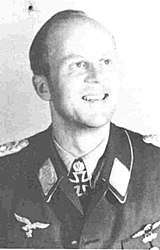Dietrich Hrabak
| Dietrich Hrabak | |
|---|---|
 | |
| Born |
19 December 1914 Großdeuben, Saxony |
| Died |
15 September 1995 (aged 80) Pfaffenhofen |
| Allegiance |
|
| Service/ |
Luftwaffe German Air Force |
| Rank |
Oberst (World War II) Generalmajor (Bundeswehr) |
| Commands held | JG 54, JG 52 |
| Battles/wars | World War II |
| Awards | Knight's Cross of the Iron Cross with Oak Leaves |
Dietrich "Dieter" Hrabak (19 December 1914 – 15 September 1995) was a German fighter pilot during World War II. Following the war, he served in the German Air Force of West Germany. A fighter ace, he claimed 125 enemy aircraft shot down in over 1000 combat missions. 109 of his victories were claimed over the Eastern Front, with 16 against the Western Allies.
Biography
Hrabak was born on 19 December 1914 in Großdeuben, part of Böhlen, in the Kingdom of Saxony, a federated state of the German Empire, the son of a real estate developer. After completing his secondary education, Hrabak joined the navy in 1934 and in November 1935 transferred to the newly emerging Luftwaffe, the air force of Nazi Germany. On 1 April 1936, Hrabak was promoted to Leutnant (second lieutenant).[1]
On 13 May 1940, he claimed his first victory, and he claimed five more victories before the armistice. During the Battle of Britain, Hrabak was a member of JG 54, becoming Gruppenkommandeur II./JG 54 on 26 August 1940. During the Battle of Britain he added ten victories against Royal Air Force (RAF) fighters and Field Marshal Hermann Göring personally decorated Hrabak with the Knight's Cross of the Iron Cross.
Hrabak served in the Balkans campaign. When Germany invaded the Soviet Union in Operation Barbarossa, he flew on the northern front and over Leningrad. In November 1942, he left JG 54 to become Geschwaderkommodore of Jagdgeschwader 52 (JG 52—52nd Fighter Wing). Under Hrabak JG 52 became the highest scoring Geschwader with over 10,000 victories.
On 2 August 1943, Hrabak claimed his 100th victory. He was the 48th Luftwaffe pilot to achieve the century mark.[2] In November 1943, Oak Leaves were added to Hrabak's Knight's Cross. On 9 December, Hrabak was presented with them by Adolf Hitler, at the Wolfschanze, Hitler's eastern military headquarters in Rastenburg (later Kętrzyn, Poland). By this time Hrabak had 118 victories.
On 20 September 1944, Hrabak scored the last of his 125 victories. In October 1944 Hrabak returned to JG 54, serving as its last Geschwaderkommodore until the end of the war. His greatest contribution to the Luftwaffe was not his combat record however but his command, tactical and leadership qualities, which endeared him to the men under his command and sealed his reputation within the Luftwaffe leadership.
In 1956 he commanded the Advanced Pilot Training Center at Fürstenfeldbruck. In 1962 he took charge of the air defense covering northern Germany and the Netherlands. In 1964 he was named NATO's Chief of Air Defense/Central Europe until becoming special manager for the Lockheed F-104 Starfighter programme. As a major general, he commanded the GAF's tactical command. Hrabak died on 15 September 1995.
Awards
- Ehrenpokal der Luftwaffe (28 September 1940)[3]
- Iron Cross (1939) 2nd class (15 September 1939) & 1st class (28 May 1940)[4]
- German Cross in Gold on 10 July 1944 as Oberstleutnant in Jagdgeschwader 52[5]
- Knight's Cross of the Iron Cross with Oak Leaves
- Knight's Cross on 21 October 1940 as Hauptmann and Gruppenkommandeur of the II./Jagdgeschwader 54[6][7]
- 337th Oak Leaves on 25 November 1943 as Oberstleutnant and Geschwaderkommodore of Jagdgeschwader 52[6][8]
References
Citations
Bibliography
- Fellgiebel, Walther-Peer (2000) [1986]. Die Träger des Ritterkreuzes des Eisernen Kreuzes 1939–1945 — Die Inhaber der höchsten Auszeichnung des Zweiten Weltkrieges aller Wehrmachtteile [The Bearers of the Knight's Cross of the Iron Cross 1939–1945 — The Owners of the Highest Award of the Second World War of all Wehrmacht Branches] (in German). Friedberg, Germany: Podzun-Pallas. ISBN 978-3-7909-0284-6.
- Obermaier, Ernst (1989). Die Ritterkreuzträger der Luftwaffe Jagdflieger 1939 – 1945 [The Knight's Cross Bearers of the Luftwaffe Fighter Force 1939 – 1945] (in German). Mainz, Germany: Verlag Dieter Hoffmann. ISBN 978-3-87341-065-7.
- Patzwall, Klaus D.; Scherzer, Veit (2001). Das Deutsche Kreuz 1941 – 1945 Geschichte und Inhaber Band II [The German Cross 1941 – 1945 History and Recipients Volume 2] (in German). Norderstedt, Germany: Verlag Klaus D. Patzwall. ISBN 978-3-931533-45-8.
- Scherzer, Veit (2007). Die Ritterkreuzträger 1939–1945 Die Inhaber des Ritterkreuzes des Eisernen Kreuzes 1939 von Heer, Luftwaffe, Kriegsmarine, Waffen-SS, Volkssturm sowie mit Deutschland verbündeter Streitkräfte nach den Unterlagen des Bundesarchives [The Knight's Cross Bearers 1939–1945 The Holders of the Knight's Cross of the Iron Cross 1939 by Army, Air Force, Navy, Waffen-SS, Volkssturm and Allied Forces with Germany According to the Documents of the Federal Archives] (in German). Jena, Germany: Scherzers Militaer-Verlag. ISBN 978-3-938845-17-2.
- Spick, Mike (1996). Luftwaffe Fighter Aces. New York: Ivy Books. ISBN 978-0-8041-1696-1.
- Stockert, Peter (1998). Die Eichenlaubträger 1939–1945 Band 4 [The Oak Leaves Bearers 1939–1945 Volume 4] (in German). Bad Friedrichshall, Germany: Friedrichshaller Rundblick. ISBN 978-3-932915-03-1.
- Thomas, Franz (1997). Die Eichenlaubträger 1939–1945 Band 1: A–K [The Oak Leaves Bearers 1939–1945 Volume 1: A–K] (in German). Osnabrück, Germany: Biblio-Verlag. ISBN 978-3-7648-2299-6.
| Military offices | ||
|---|---|---|
| Preceded by Major Herbert Ihlefeld |
Commander of Jagdgeschwader 52 1 November 1942 – 30 September 1944 |
Succeeded by Oberstleutnant Hermann Graf |
| Preceded by Oberstleutnant Anton Mader |
Commander of Jagdgeschwader 54 Grünherz 1 October 1944 – 8 May 1945 |
Succeeded by none |